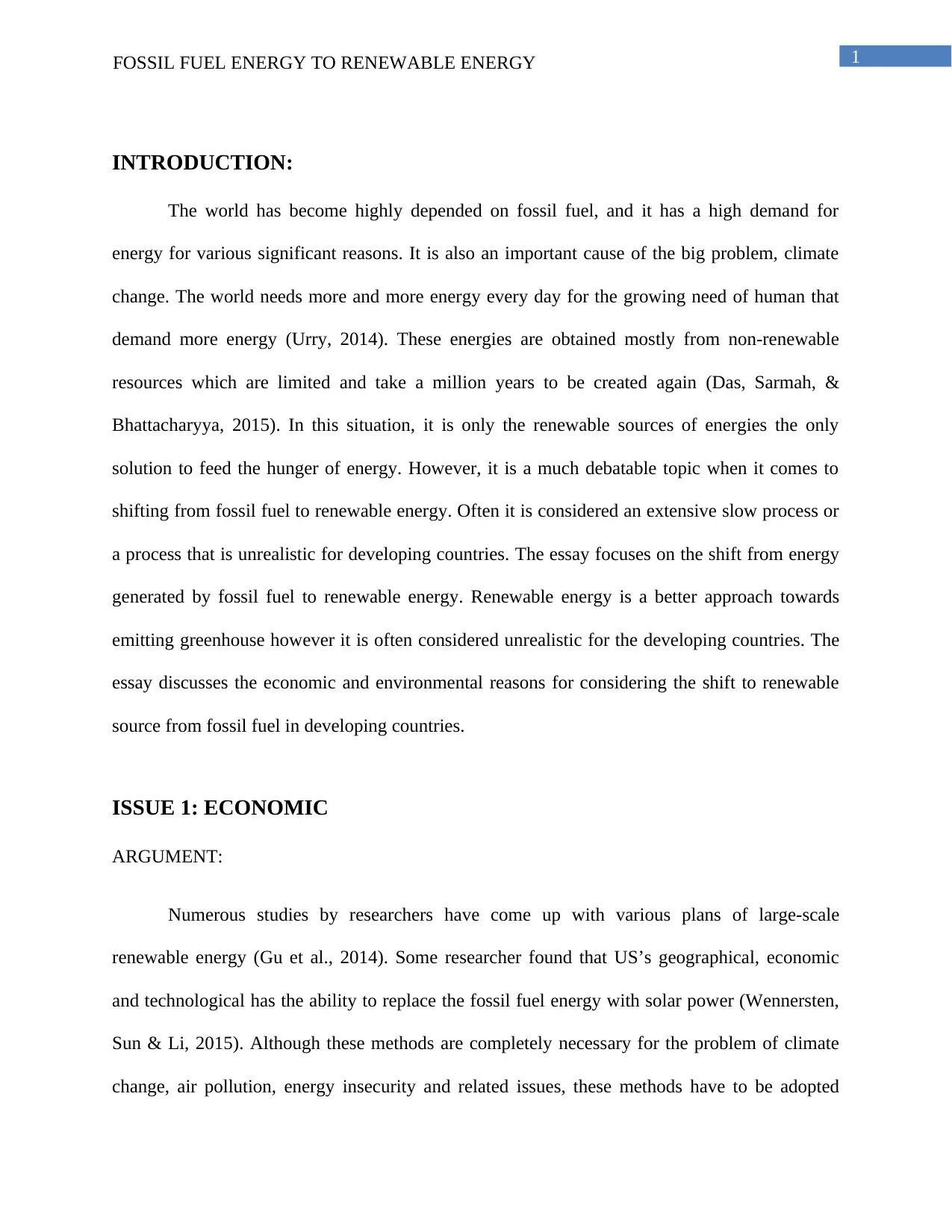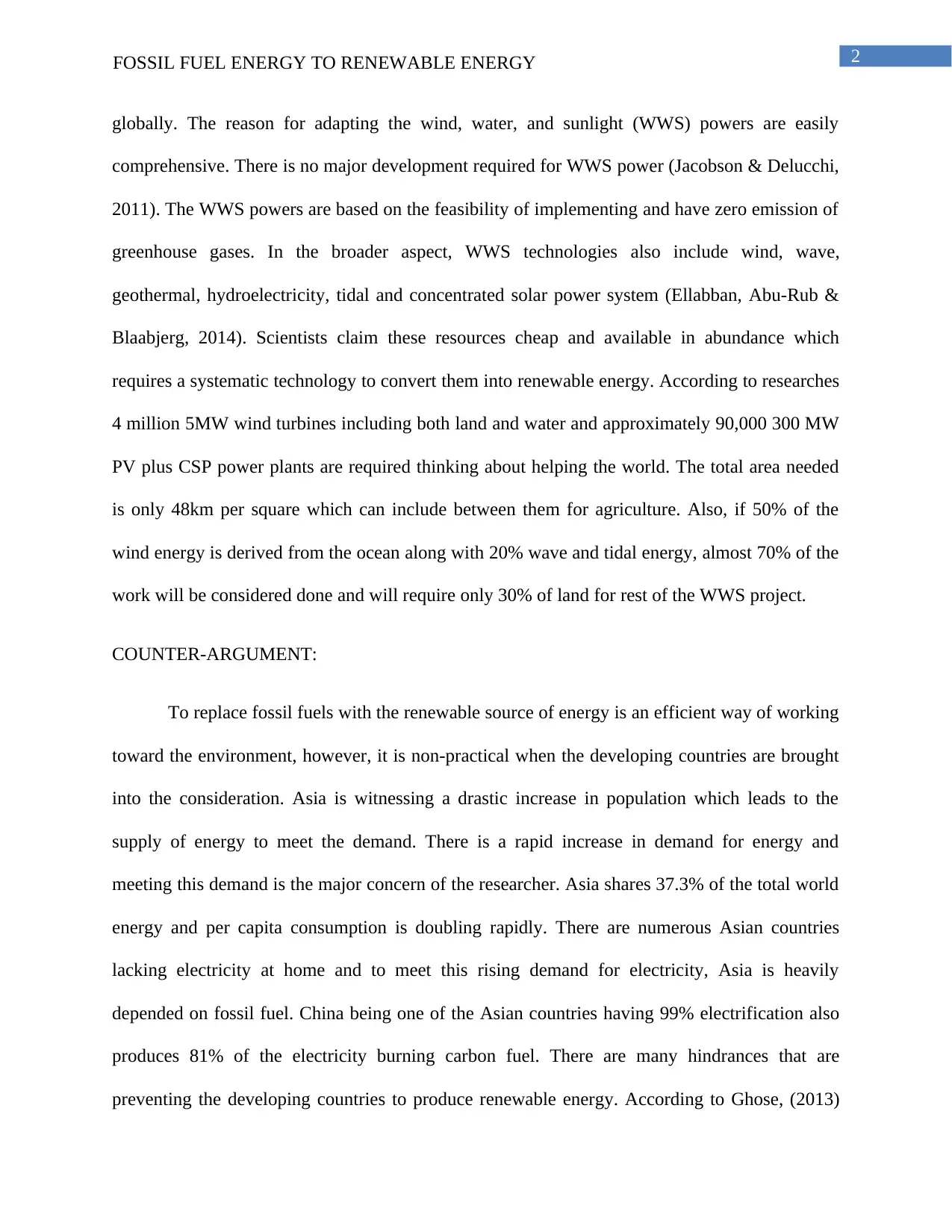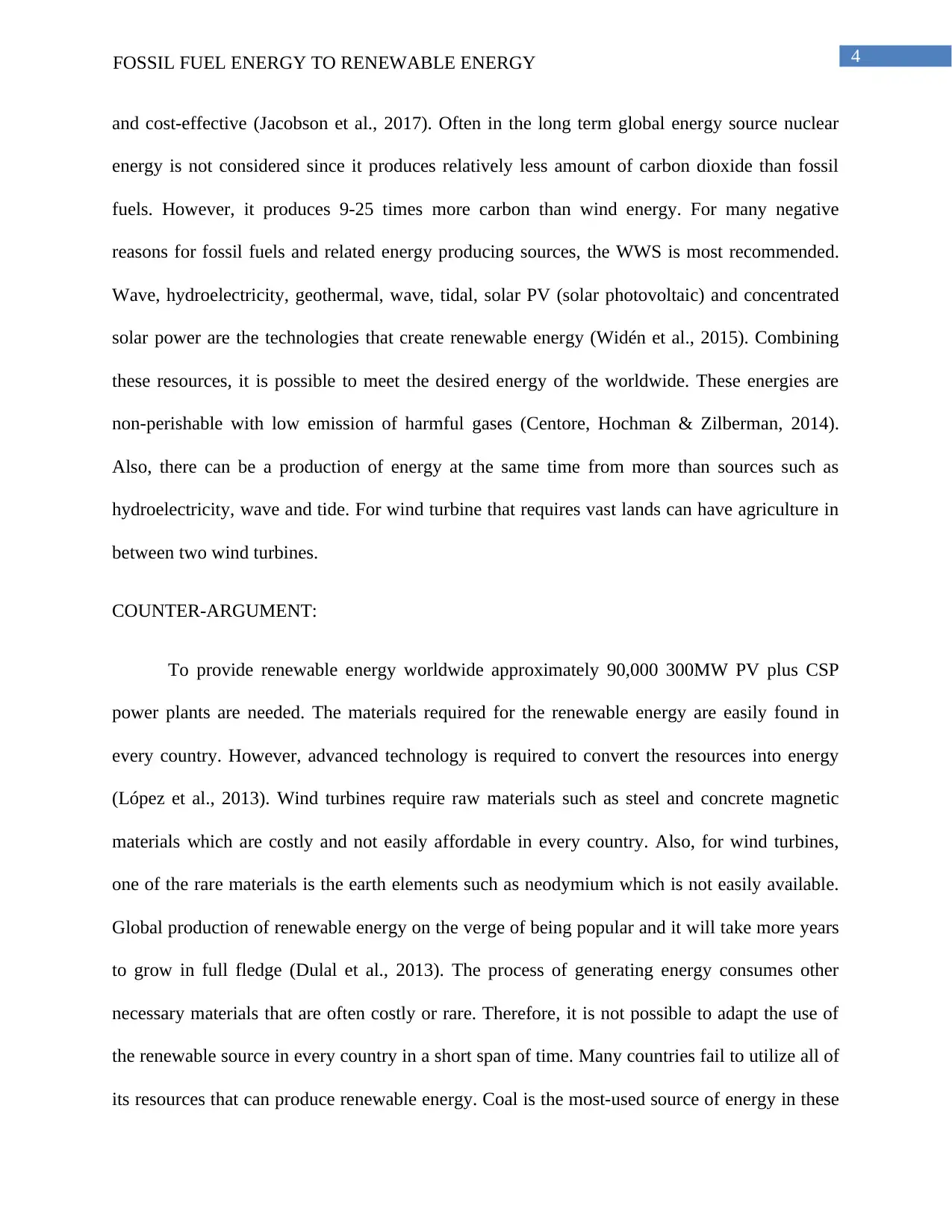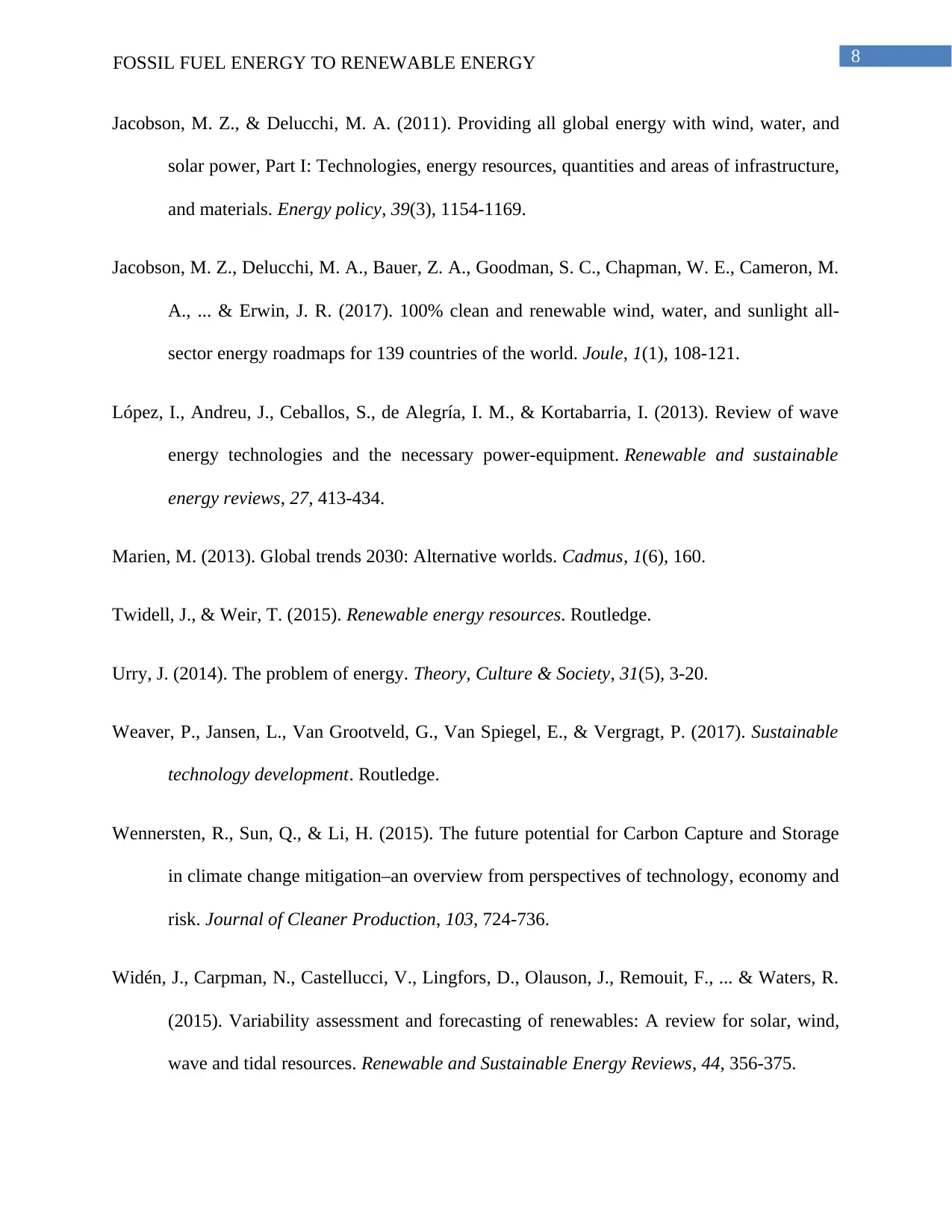Fossil Fuel Energy to Renewable Energy
VerifiedAdded on 2023/06/08
|10
|2456
|400
AI Summary
The essay discusses the shift from energy generated by fossil fuel to renewable energy. It explores the economic and environmental reasons for considering the shift to renewable source from fossil fuel in developing countries. The essay also talks about the feasibility of implementing wind, water, and sunlight (WWS) powers globally.
Contribute Materials
Your contribution can guide someone’s learning journey. Share your
documents today.

Running head: FOSSIL FUEL ENERGY TO RENEWABLE ENERGY
FOSSIL FUEL ENERGY TO RENEWABLE ENERGY
Name of the student:
Name of the university:
Author note:
FOSSIL FUEL ENERGY TO RENEWABLE ENERGY
Name of the student:
Name of the university:
Author note:
Secure Best Marks with AI Grader
Need help grading? Try our AI Grader for instant feedback on your assignments.

1FOSSIL FUEL ENERGY TO RENEWABLE ENERGY
INTRODUCTION:
The world has become highly depended on fossil fuel, and it has a high demand for
energy for various significant reasons. It is also an important cause of the big problem, climate
change. The world needs more and more energy every day for the growing need of human that
demand more energy (Urry, 2014). These energies are obtained mostly from non-renewable
resources which are limited and take a million years to be created again (Das, Sarmah, &
Bhattacharyya, 2015). In this situation, it is only the renewable sources of energies the only
solution to feed the hunger of energy. However, it is a much debatable topic when it comes to
shifting from fossil fuel to renewable energy. Often it is considered an extensive slow process or
a process that is unrealistic for developing countries. The essay focuses on the shift from energy
generated by fossil fuel to renewable energy. Renewable energy is a better approach towards
emitting greenhouse however it is often considered unrealistic for the developing countries. The
essay discusses the economic and environmental reasons for considering the shift to renewable
source from fossil fuel in developing countries.
ISSUE 1: ECONOMIC
ARGUMENT:
Numerous studies by researchers have come up with various plans of large-scale
renewable energy (Gu et al., 2014). Some researcher found that US’s geographical, economic
and technological has the ability to replace the fossil fuel energy with solar power (Wennersten,
Sun & Li, 2015). Although these methods are completely necessary for the problem of climate
change, air pollution, energy insecurity and related issues, these methods have to be adopted
INTRODUCTION:
The world has become highly depended on fossil fuel, and it has a high demand for
energy for various significant reasons. It is also an important cause of the big problem, climate
change. The world needs more and more energy every day for the growing need of human that
demand more energy (Urry, 2014). These energies are obtained mostly from non-renewable
resources which are limited and take a million years to be created again (Das, Sarmah, &
Bhattacharyya, 2015). In this situation, it is only the renewable sources of energies the only
solution to feed the hunger of energy. However, it is a much debatable topic when it comes to
shifting from fossil fuel to renewable energy. Often it is considered an extensive slow process or
a process that is unrealistic for developing countries. The essay focuses on the shift from energy
generated by fossil fuel to renewable energy. Renewable energy is a better approach towards
emitting greenhouse however it is often considered unrealistic for the developing countries. The
essay discusses the economic and environmental reasons for considering the shift to renewable
source from fossil fuel in developing countries.
ISSUE 1: ECONOMIC
ARGUMENT:
Numerous studies by researchers have come up with various plans of large-scale
renewable energy (Gu et al., 2014). Some researcher found that US’s geographical, economic
and technological has the ability to replace the fossil fuel energy with solar power (Wennersten,
Sun & Li, 2015). Although these methods are completely necessary for the problem of climate
change, air pollution, energy insecurity and related issues, these methods have to be adopted

2FOSSIL FUEL ENERGY TO RENEWABLE ENERGY
globally. The reason for adapting the wind, water, and sunlight (WWS) powers are easily
comprehensive. There is no major development required for WWS power (Jacobson & Delucchi,
2011). The WWS powers are based on the feasibility of implementing and have zero emission of
greenhouse gases. In the broader aspect, WWS technologies also include wind, wave,
geothermal, hydroelectricity, tidal and concentrated solar power system (Ellabban, Abu-Rub &
Blaabjerg, 2014). Scientists claim these resources cheap and available in abundance which
requires a systematic technology to convert them into renewable energy. According to researches
4 million 5MW wind turbines including both land and water and approximately 90,000 300 MW
PV plus CSP power plants are required thinking about helping the world. The total area needed
is only 48km per square which can include between them for agriculture. Also, if 50% of the
wind energy is derived from the ocean along with 20% wave and tidal energy, almost 70% of the
work will be considered done and will require only 30% of land for rest of the WWS project.
COUNTER-ARGUMENT:
To replace fossil fuels with the renewable source of energy is an efficient way of working
toward the environment, however, it is non-practical when the developing countries are brought
into the consideration. Asia is witnessing a drastic increase in population which leads to the
supply of energy to meet the demand. There is a rapid increase in demand for energy and
meeting this demand is the major concern of the researcher. Asia shares 37.3% of the total world
energy and per capita consumption is doubling rapidly. There are numerous Asian countries
lacking electricity at home and to meet this rising demand for electricity, Asia is heavily
depended on fossil fuel. China being one of the Asian countries having 99% electrification also
produces 81% of the electricity burning carbon fuel. There are many hindrances that are
preventing the developing countries to produce renewable energy. According to Ghose, (2013)
globally. The reason for adapting the wind, water, and sunlight (WWS) powers are easily
comprehensive. There is no major development required for WWS power (Jacobson & Delucchi,
2011). The WWS powers are based on the feasibility of implementing and have zero emission of
greenhouse gases. In the broader aspect, WWS technologies also include wind, wave,
geothermal, hydroelectricity, tidal and concentrated solar power system (Ellabban, Abu-Rub &
Blaabjerg, 2014). Scientists claim these resources cheap and available in abundance which
requires a systematic technology to convert them into renewable energy. According to researches
4 million 5MW wind turbines including both land and water and approximately 90,000 300 MW
PV plus CSP power plants are required thinking about helping the world. The total area needed
is only 48km per square which can include between them for agriculture. Also, if 50% of the
wind energy is derived from the ocean along with 20% wave and tidal energy, almost 70% of the
work will be considered done and will require only 30% of land for rest of the WWS project.
COUNTER-ARGUMENT:
To replace fossil fuels with the renewable source of energy is an efficient way of working
toward the environment, however, it is non-practical when the developing countries are brought
into the consideration. Asia is witnessing a drastic increase in population which leads to the
supply of energy to meet the demand. There is a rapid increase in demand for energy and
meeting this demand is the major concern of the researcher. Asia shares 37.3% of the total world
energy and per capita consumption is doubling rapidly. There are numerous Asian countries
lacking electricity at home and to meet this rising demand for electricity, Asia is heavily
depended on fossil fuel. China being one of the Asian countries having 99% electrification also
produces 81% of the electricity burning carbon fuel. There are many hindrances that are
preventing the developing countries to produce renewable energy. According to Ghose, (2013)

3FOSSIL FUEL ENERGY TO RENEWABLE ENERGY
cost is one of the major contributing factors. To increase the production of renewable source, the
most needed factor in the advanced technology which requires monetary support and developing
countries fail to afford such advanced technologies. The government of these countries lacks the
funds to invest in renewable energy along with high up-front cost.
REFUTATION:
Most experts say the US can run only on wind or other renewable energy however it is
nor same for the rest of the world. The developed country is self-sufficient along with high end
infrastructure which makes it say renewable energy as a feasible achievement (Weaver et al.,
2017). When the developing countries are lacking various basic needs and a large number of
populations are living below the poverty line, the priority is only food, shelter and clothing.
Countries such as Japan, China, Korea, India, Singapore, Thailand and Malaysia are seeking
more ways to invest in renewable energy. However, the developing countries should be provided
with aids from the developed countries.
ISSUE 2: ENVIRONMENTAL
ARGUMENT
Experts agree the impact of excessive use of non-renewable energy and that is the reason
why researchers are working on the finding various ways to use renewable energy. The US has
been identified as one of the countries where there is a potential for replacing its fossil fuels with
renewable sources with large-scale renewable energy plans (Marien, 2013). The primary energy
sources are wind, water and sunlight. These resources are available in abundance hence can be
used to produce energy to fulfil human needs. WWS options are much suitable for the climate
cost is one of the major contributing factors. To increase the production of renewable source, the
most needed factor in the advanced technology which requires monetary support and developing
countries fail to afford such advanced technologies. The government of these countries lacks the
funds to invest in renewable energy along with high up-front cost.
REFUTATION:
Most experts say the US can run only on wind or other renewable energy however it is
nor same for the rest of the world. The developed country is self-sufficient along with high end
infrastructure which makes it say renewable energy as a feasible achievement (Weaver et al.,
2017). When the developing countries are lacking various basic needs and a large number of
populations are living below the poverty line, the priority is only food, shelter and clothing.
Countries such as Japan, China, Korea, India, Singapore, Thailand and Malaysia are seeking
more ways to invest in renewable energy. However, the developing countries should be provided
with aids from the developed countries.
ISSUE 2: ENVIRONMENTAL
ARGUMENT
Experts agree the impact of excessive use of non-renewable energy and that is the reason
why researchers are working on the finding various ways to use renewable energy. The US has
been identified as one of the countries where there is a potential for replacing its fossil fuels with
renewable sources with large-scale renewable energy plans (Marien, 2013). The primary energy
sources are wind, water and sunlight. These resources are available in abundance hence can be
used to produce energy to fulfil human needs. WWS options are much suitable for the climate
Secure Best Marks with AI Grader
Need help grading? Try our AI Grader for instant feedback on your assignments.

4FOSSIL FUEL ENERGY TO RENEWABLE ENERGY
and cost-effective (Jacobson et al., 2017). Often in the long term global energy source nuclear
energy is not considered since it produces relatively less amount of carbon dioxide than fossil
fuels. However, it produces 9-25 times more carbon than wind energy. For many negative
reasons for fossil fuels and related energy producing sources, the WWS is most recommended.
Wave, hydroelectricity, geothermal, wave, tidal, solar PV (solar photovoltaic) and concentrated
solar power are the technologies that create renewable energy (Widén et al., 2015). Combining
these resources, it is possible to meet the desired energy of the worldwide. These energies are
non-perishable with low emission of harmful gases (Centore, Hochman & Zilberman, 2014).
Also, there can be a production of energy at the same time from more than sources such as
hydroelectricity, wave and tide. For wind turbine that requires vast lands can have agriculture in
between two wind turbines.
COUNTER-ARGUMENT:
To provide renewable energy worldwide approximately 90,000 300MW PV plus CSP
power plants are needed. The materials required for the renewable energy are easily found in
every country. However, advanced technology is required to convert the resources into energy
(López et al., 2013). Wind turbines require raw materials such as steel and concrete magnetic
materials which are costly and not easily affordable in every country. Also, for wind turbines,
one of the rare materials is the earth elements such as neodymium which is not easily available.
Global production of renewable energy on the verge of being popular and it will take more years
to grow in full fledge (Dulal et al., 2013). The process of generating energy consumes other
necessary materials that are often costly or rare. Therefore, it is not possible to adapt the use of
the renewable source in every country in a short span of time. Many countries fail to utilize all of
its resources that can produce renewable energy. Coal is the most-used source of energy in these
and cost-effective (Jacobson et al., 2017). Often in the long term global energy source nuclear
energy is not considered since it produces relatively less amount of carbon dioxide than fossil
fuels. However, it produces 9-25 times more carbon than wind energy. For many negative
reasons for fossil fuels and related energy producing sources, the WWS is most recommended.
Wave, hydroelectricity, geothermal, wave, tidal, solar PV (solar photovoltaic) and concentrated
solar power are the technologies that create renewable energy (Widén et al., 2015). Combining
these resources, it is possible to meet the desired energy of the worldwide. These energies are
non-perishable with low emission of harmful gases (Centore, Hochman & Zilberman, 2014).
Also, there can be a production of energy at the same time from more than sources such as
hydroelectricity, wave and tide. For wind turbine that requires vast lands can have agriculture in
between two wind turbines.
COUNTER-ARGUMENT:
To provide renewable energy worldwide approximately 90,000 300MW PV plus CSP
power plants are needed. The materials required for the renewable energy are easily found in
every country. However, advanced technology is required to convert the resources into energy
(López et al., 2013). Wind turbines require raw materials such as steel and concrete magnetic
materials which are costly and not easily affordable in every country. Also, for wind turbines,
one of the rare materials is the earth elements such as neodymium which is not easily available.
Global production of renewable energy on the verge of being popular and it will take more years
to grow in full fledge (Dulal et al., 2013). The process of generating energy consumes other
necessary materials that are often costly or rare. Therefore, it is not possible to adapt the use of
the renewable source in every country in a short span of time. Many countries fail to utilize all of
its resources that can produce renewable energy. Coal is the most-used source of energy in these

5FOSSIL FUEL ENERGY TO RENEWABLE ENERGY
countries. Therefore, the only way to move to renewable energy from fossil fuel can be through
strict government policies and government initiative for renewable energy.
REFUTATION:
According to Twidell and Weir, (2015) every country is not blessed to have potential
natural resources to generate renewable energy. However, every country will have one or the
other source of natural resources that can be used to produce the renewable resource. Therefore,
it is important for every country to find out the potential source of their countries. Countries
lacking funds can seek help from the foreign countries for the improvement and development.
The government of the developing countries needs to implement policies and invest in the
infrastructure. The natural resources should be used to the fullest focus on the renewable energy
and control of the fossil fuel energy. The government should also be concerned about the
emission of greenhouse gases need to be controlled by policies and laws. The private companies
need to manage regulation of fossil fuel energy and also contribute to help building technologies
to generate renewable sources.
CONCLUSION
The source of carbon-free electricity is only possible by generating electricity primarily
from wind, water and sunlight. They are a presence in the environment endlessly, therefore; they
can be turned off and on. However, in the clear view when is broadly accepted that wind, water
and sunlight is the only source of energy that will replace and help fossil fuel energy, it is still
not adopted worldwide. The plain reason that can be held responsible at the end of this essay is
the lack of resources. The developing countries lack the funds to invest to generate the renewable
energy. The countries where electrification has not occurred entirely in every region they rely
countries. Therefore, the only way to move to renewable energy from fossil fuel can be through
strict government policies and government initiative for renewable energy.
REFUTATION:
According to Twidell and Weir, (2015) every country is not blessed to have potential
natural resources to generate renewable energy. However, every country will have one or the
other source of natural resources that can be used to produce the renewable resource. Therefore,
it is important for every country to find out the potential source of their countries. Countries
lacking funds can seek help from the foreign countries for the improvement and development.
The government of the developing countries needs to implement policies and invest in the
infrastructure. The natural resources should be used to the fullest focus on the renewable energy
and control of the fossil fuel energy. The government should also be concerned about the
emission of greenhouse gases need to be controlled by policies and laws. The private companies
need to manage regulation of fossil fuel energy and also contribute to help building technologies
to generate renewable sources.
CONCLUSION
The source of carbon-free electricity is only possible by generating electricity primarily
from wind, water and sunlight. They are a presence in the environment endlessly, therefore; they
can be turned off and on. However, in the clear view when is broadly accepted that wind, water
and sunlight is the only source of energy that will replace and help fossil fuel energy, it is still
not adopted worldwide. The plain reason that can be held responsible at the end of this essay is
the lack of resources. The developing countries lack the funds to invest to generate the renewable
energy. The countries where electrification has not occurred entirely in every region they rely

6FOSSIL FUEL ENERGY TO RENEWABLE ENERGY
heavily on the fossil fuel energy since it is easily available and affordable. Although many Asian
countries, developed and developing, are working on generating the renewable source of energy
to meet their needs, it still requires years to see the desired change.
heavily on the fossil fuel energy since it is easily available and affordable. Although many Asian
countries, developed and developing, are working on generating the renewable source of energy
to meet their needs, it still requires years to see the desired change.
Paraphrase This Document
Need a fresh take? Get an instant paraphrase of this document with our AI Paraphraser

7FOSSIL FUEL ENERGY TO RENEWABLE ENERGY
Referencing:
Centore, M., Hochman, G., & Zilberman, D. (2014). Worldwide survey of biodegradable
feedstocks, waste-to-energy technologies, and adoption of technologies. In Modeling,
Dynamics, Optimization and Bioeconomics I (pp. 163-181). Springer, Cham.
Das, O., Sarmah, A. K., & Bhattacharyya, D. (2015). A sustainable and resilient approach
through biochar addition in wood polymer composites. Science of the Total
Environment, 512, 326-336.
Dulal, H. B., Shah, K. U., Sapkota, C., Uma, G., & Kandel, B. R. (2013). Renewable energy
diffusion in Asia: Can it happen without government support?. Energy Policy, 59, 301-
311.
Ellabban, O., Abu-Rub, H., & Blaabjerg, F. (2014). Renewable energy resources: Current status,
future prospects and their enabling technology. Renewable and Sustainable Energy
Reviews, 39, 748-764.
Ghose, M. K. (2013). Meeting the Challenges of Sustainable Development of Energy Through
Clean Coal Technologies. TIDEE (TERI Information Digest on Energy &
Environment), 12(2).
Gu, W., Wu, Z., Bo, R., Liu, W., Zhou, G., Chen, W., & Wu, Z. (2014). Modeling, planning and
optimal energy management of combined cooling, heating and power microgrid: A
review. International Journal of Electrical Power & Energy Systems, 54, 26-37.
Referencing:
Centore, M., Hochman, G., & Zilberman, D. (2014). Worldwide survey of biodegradable
feedstocks, waste-to-energy technologies, and adoption of technologies. In Modeling,
Dynamics, Optimization and Bioeconomics I (pp. 163-181). Springer, Cham.
Das, O., Sarmah, A. K., & Bhattacharyya, D. (2015). A sustainable and resilient approach
through biochar addition in wood polymer composites. Science of the Total
Environment, 512, 326-336.
Dulal, H. B., Shah, K. U., Sapkota, C., Uma, G., & Kandel, B. R. (2013). Renewable energy
diffusion in Asia: Can it happen without government support?. Energy Policy, 59, 301-
311.
Ellabban, O., Abu-Rub, H., & Blaabjerg, F. (2014). Renewable energy resources: Current status,
future prospects and their enabling technology. Renewable and Sustainable Energy
Reviews, 39, 748-764.
Ghose, M. K. (2013). Meeting the Challenges of Sustainable Development of Energy Through
Clean Coal Technologies. TIDEE (TERI Information Digest on Energy &
Environment), 12(2).
Gu, W., Wu, Z., Bo, R., Liu, W., Zhou, G., Chen, W., & Wu, Z. (2014). Modeling, planning and
optimal energy management of combined cooling, heating and power microgrid: A
review. International Journal of Electrical Power & Energy Systems, 54, 26-37.

8FOSSIL FUEL ENERGY TO RENEWABLE ENERGY
Jacobson, M. Z., & Delucchi, M. A. (2011). Providing all global energy with wind, water, and
solar power, Part I: Technologies, energy resources, quantities and areas of infrastructure,
and materials. Energy policy, 39(3), 1154-1169.
Jacobson, M. Z., Delucchi, M. A., Bauer, Z. A., Goodman, S. C., Chapman, W. E., Cameron, M.
A., ... & Erwin, J. R. (2017). 100% clean and renewable wind, water, and sunlight all-
sector energy roadmaps for 139 countries of the world. Joule, 1(1), 108-121.
López, I., Andreu, J., Ceballos, S., de Alegría, I. M., & Kortabarria, I. (2013). Review of wave
energy technologies and the necessary power-equipment. Renewable and sustainable
energy reviews, 27, 413-434.
Marien, M. (2013). Global trends 2030: Alternative worlds. Cadmus, 1(6), 160.
Twidell, J., & Weir, T. (2015). Renewable energy resources. Routledge.
Urry, J. (2014). The problem of energy. Theory, Culture & Society, 31(5), 3-20.
Weaver, P., Jansen, L., Van Grootveld, G., Van Spiegel, E., & Vergragt, P. (2017). Sustainable
technology development. Routledge.
Wennersten, R., Sun, Q., & Li, H. (2015). The future potential for Carbon Capture and Storage
in climate change mitigation–an overview from perspectives of technology, economy and
risk. Journal of Cleaner Production, 103, 724-736.
Widén, J., Carpman, N., Castellucci, V., Lingfors, D., Olauson, J., Remouit, F., ... & Waters, R.
(2015). Variability assessment and forecasting of renewables: A review for solar, wind,
wave and tidal resources. Renewable and Sustainable Energy Reviews, 44, 356-375.
Jacobson, M. Z., & Delucchi, M. A. (2011). Providing all global energy with wind, water, and
solar power, Part I: Technologies, energy resources, quantities and areas of infrastructure,
and materials. Energy policy, 39(3), 1154-1169.
Jacobson, M. Z., Delucchi, M. A., Bauer, Z. A., Goodman, S. C., Chapman, W. E., Cameron, M.
A., ... & Erwin, J. R. (2017). 100% clean and renewable wind, water, and sunlight all-
sector energy roadmaps for 139 countries of the world. Joule, 1(1), 108-121.
López, I., Andreu, J., Ceballos, S., de Alegría, I. M., & Kortabarria, I. (2013). Review of wave
energy technologies and the necessary power-equipment. Renewable and sustainable
energy reviews, 27, 413-434.
Marien, M. (2013). Global trends 2030: Alternative worlds. Cadmus, 1(6), 160.
Twidell, J., & Weir, T. (2015). Renewable energy resources. Routledge.
Urry, J. (2014). The problem of energy. Theory, Culture & Society, 31(5), 3-20.
Weaver, P., Jansen, L., Van Grootveld, G., Van Spiegel, E., & Vergragt, P. (2017). Sustainable
technology development. Routledge.
Wennersten, R., Sun, Q., & Li, H. (2015). The future potential for Carbon Capture and Storage
in climate change mitigation–an overview from perspectives of technology, economy and
risk. Journal of Cleaner Production, 103, 724-736.
Widén, J., Carpman, N., Castellucci, V., Lingfors, D., Olauson, J., Remouit, F., ... & Waters, R.
(2015). Variability assessment and forecasting of renewables: A review for solar, wind,
wave and tidal resources. Renewable and Sustainable Energy Reviews, 44, 356-375.

9FOSSIL FUEL ENERGY TO RENEWABLE ENERGY
1 out of 10
Related Documents
Your All-in-One AI-Powered Toolkit for Academic Success.
+13062052269
info@desklib.com
Available 24*7 on WhatsApp / Email
![[object Object]](/_next/static/media/star-bottom.7253800d.svg)
Unlock your academic potential
© 2024 | Zucol Services PVT LTD | All rights reserved.





